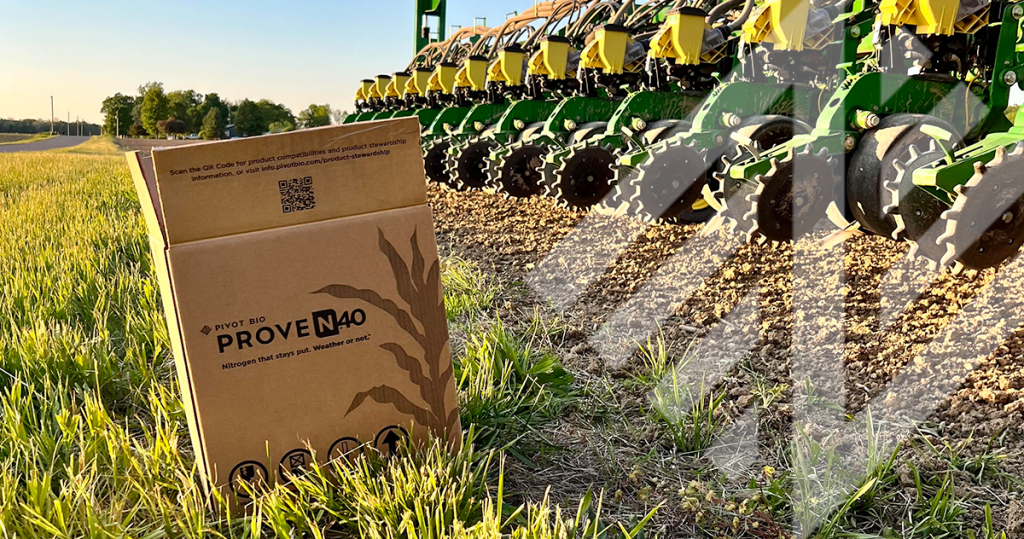Has Synthetic Nitrogen Hit The Limit?

From large farms to vegetable gardens, the conventional wisdom says that crops need synthetic nitrogen fertilizer to produce high yields. At Pivot Bio, we like to put convention under the microscope and ask ourselves, what if there’s a better way?
In this blog series, The Seventh Element: Our First Priority, we’re exploring nitrogen as the foundation of all life, and what nitrogen innovations mean for farmers and our planet.
Nitrogen is everywhere, making up 78% of our atmosphere. It comes in many forms but only a few are biologically available to the organisms that need it to survive, including plants. Nitrogen is often the limiting factor for farmers and something they need to carefully manage. Many farmers operate with narrow profit margins and even narrower margins for error – they need to be confident with their nitrogen.
Farmers have used fertilizer to provide nitrogen to their crops, going back to Indigenous people who used fish remains to fertilize plants. In the mid-1800s, the United States imported bird guano from Peru as a fertilizer so farmers could continue to use the same fields season after season without depleting soil nutrients. Then, in the late 1800s, as the global population skyrocketed powered by the Industrial Revolution, the British Association for the Advancement of Science announced a call for scientists around the world to find a way to produce a plant-available form of nitrogen that didn’t rely on a dwindling supply of guano so farmers could keep up with an ever-increasing demand for food production.
A German chemist named Fritz Haber discovered a method of using hydrogen and nitrogen to synthesize ammonia. Later, industrial chemist Carl Bosch figured out how to scale the process for mass production. Today, this process is called the Haber-Bosch process. The Haber-Bosch process takes nitrogen from the air and combines it with hydrogen under high temperatures and extremely high pressure to create ammonia fertilizer. There is a catch – while atmospheric nitrogen is abundant, it is extremely difficult to transform into a biologically available form. Atmospheric nitrogen, N2, is made of two nitrogen atoms that are triple bonded to each other. These bonds are stable, strong, and incredibly energy-intensive to break. The Haber-Bosch process uses 2% of the entire world’s energy consumption to create ammonia fertilizers.
The Haber-Bosch process unlocked a limitless supply of atmospheric nitrogen in order to support agriculture. At the time, it seemed like an excellent solution so, for over a hundred years, relatively inexpensive synthetic nitrogen fertilizers were used in farming. Unfortunately, a century later, the true expense of synthetic fertilizer use has become clear.
Nitrogen is the nutrient most likely to be lost to the environment, so farmers carefully manage applications to balance supplying enough nitrogen with the known nutrient loss, compounded by environmental factors that can further increase losses. Even with careful management, only about half of applied nitrogen makes it to the plant.
So, if a farmer applies 200 lbs. of nitrogen per acre of corn, knowing only about 100 lbs. will reach the crop, where does the other half go? There are three primary forms of nutrient loss: leaching, denitrification, and surface volatilization. Leaching accounts for about 10-20% of nitrogen loss, and happens when nitrate (a negatively charged form of nitrogen) is repelled by other negatively charged elements in the soil, and moves into the groundwater. It is highly soluble and moves easily through water.
Denitrification is when nitrogen is lost to the atmosphere, and is the route by which most gaseous forms of nitrogen enter the air. Certain soil microbes take advantage of the presence of nitrogen fertilizer for their own purposes. In the process, they transform nitrite into nitrous oxide, a dangerous greenhouse gas. Denitrification occurs more frequently when soil oxygen levels are lower, and under the right circumstances, denitrification can result in the loss of up to 10 lbs of nitrogen per acre per day. Similarly, surface volatilization is a form of applied nitrogen loss to the atmosphere. This process occurs when fertilizer containing urea encounters environmental conditions that convert the urea to ammonia, which evaporates into the atmosphere. Numerous factors influence surface volatilization, including soil moisture, pH levels, organic content level, and air temperature.
Synthetic nitrogen loss is inevitable, and even though the production of synthetic nitrogen has become more efficient over the past century, it is still highly energy and resource intensive. Nitrogen fertilizer application remains the most extensive energy input in corn production. Until now, farmers haven’t had any other option but to continue using synthetic nitrogen fertilizers to keep up with demand. It’s estimated that half of all calories consumed globally today are made possible by synthetic nitrogen fertilizers.
Scientists at Pivot Bio have spent the last decade unlocking the natural ability of soil microbes to fix nitrogen from the atmosphere in order to give farmers an option to replace synthetic fertilizer and reduce the negative environmental effects of excess nitrogen. In our next and last post of our series, the Seventh Element: Our First Priority, we’ll explore how Pivot Bio uses nature, science and innovation to deliver nitrogen to crops.
We’re at a turning point in the history of agriculture, and are facing a reckoning with synthetic nitrogen. Learn more about how we got to where we are, and what a better future can look like in the next post.


